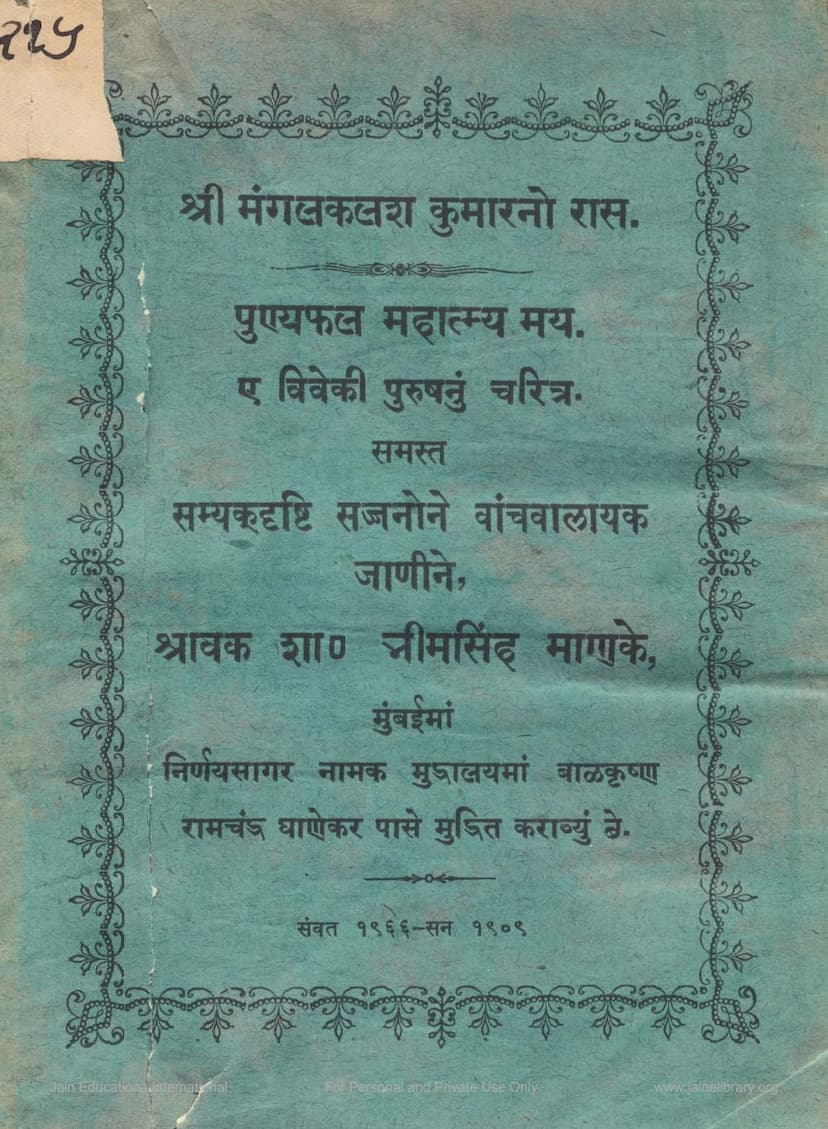Mangalkalash Kumar Ras
Added to library: September 2, 2025

Summary
This document is a Jain text titled "Mangalkalash Kumar Ras," authored by Shravak Bhimsinh Manek and published by the same. It was printed in 1909 (Samvat 1966). The text is a narrative poem, likely a ras or ballad, detailing the life and virtues of Mangalkalash Kumar.
The text is structured into several chapters or sections, indicated by headings like " ॥ अथ॥ ॥श्री मंगलकलश रासः प्रारज्यते ॥ " (Now, the Mangalkalash Kumar Ras begins), "॥ ढाल पहेली ॥" (Tale/Chapter First), "॥ ढाल बीजी ॥" (Tale/Chapter Second), and so on.
Key themes and content covered in the initial pages include:
- Invocation and Dedication: The author begins with invocations to Saraswati (the goddess of knowledge) and his spiritual guru, highlighting their importance and the blessings sought for writing the work.
- Praise of Virtues: The text emphasizes the importance of good deeds, righteous conduct, charity, pilgrimage, and devotion to God and Guru. It suggests that these actions lead to happiness, prosperity, and spiritual liberation.
- Introduction of Setting and Characters:
- The story is set in Jambudvipa, specifically in Malwa country, in a city described as being like Amaravati (the celestial city of Indra).
- The king of this land is King Vairsingh, who is brave, courageous, and compassionate, practicing jivdaya (compassion for living beings).
- The queen is named Somchandra, described as a mine of virtues and speaking sweetly.
- A prominent businessman in the city is Dhanadatta Shah, who is generous and a proud follower of Jainism.
- His wife is named Satyānāmā, who is virtuous and modest.
- The Desire for a Child: Dhanadatta and Satyānāmā are depicted as wealthy and virtuous but are distressed by their childlessness. Satyānāmā expresses her sorrow to Dhanadatta.
- The Path to Progeny: Satyānāmā advises Dhanadatta to engage in meritorious deeds, such as serving the gods and gurus, practicing charity (pancavidh dan), visiting pilgrimage sites like Shatrunjaya and Girnar, and performing acts of service and charity for the welfare of others. She believes these actions will lead to the birth of a virtuous child.
- The Birth of Mangalkalash Kumar: Following these devotional practices, Satyānāmā has a dream where she holds a lotus. Subsequently, she conceives and gives birth to a beautiful son named Mangalkalash Kumar.
- Mangalkalash's Early Life and Devotion: Mangalkalash Kumar is described as a handsome and virtuous child. He accompanies his father to the temple to offer flowers to the Jinvar (Jina's image), showing an early inclination towards devotion and religious activities.
- A Parallel Narrative (Champa Puri): A second narrative is introduced about King Sursundar of Champa Puri and his wife, who dreamt of a wish-fulfilling tree (kalpavriksha) and longed for a child. Their daughter, Trilokyasundari, is born.
- The Marriage Dilemma: King Sursundar wishes to find a suitable match for his daughter, Trilokyasundari. He considers his chief minister's son, Subuddhi, who is described as having a physical affliction (leprosy). This creates a conflict for the minister.
- Minister's Plea to the Goddess: The minister, Subuddhi, resorts to austerities and worships his family deity to find a cure for his son and secure a good match for Trilokyasundari.
- The Goddess's Guidance: The family deity appears and advises the minister to find a handsome and virtuous boy in Champak Udyan (a garden) near the abode of the horse keeper.
- The Search and the Encounter: Subuddhi follows the goddess's instructions. Meanwhile, Mangalkalash, while on his way to offer flowers, encounters Trilokyasundari, who is also disguised or seeking something in the garden. There's a hint of attraction or recognition.
The initial sections lay the groundwork for the main narrative, focusing on the importance of righteous living, the desire for progeny, and the eventual birth and early life of Mangalkalash Kumar, while also introducing a parallel story that seems to intersect with his own. The text uses a poetic and devotional style, common in Jain literature.